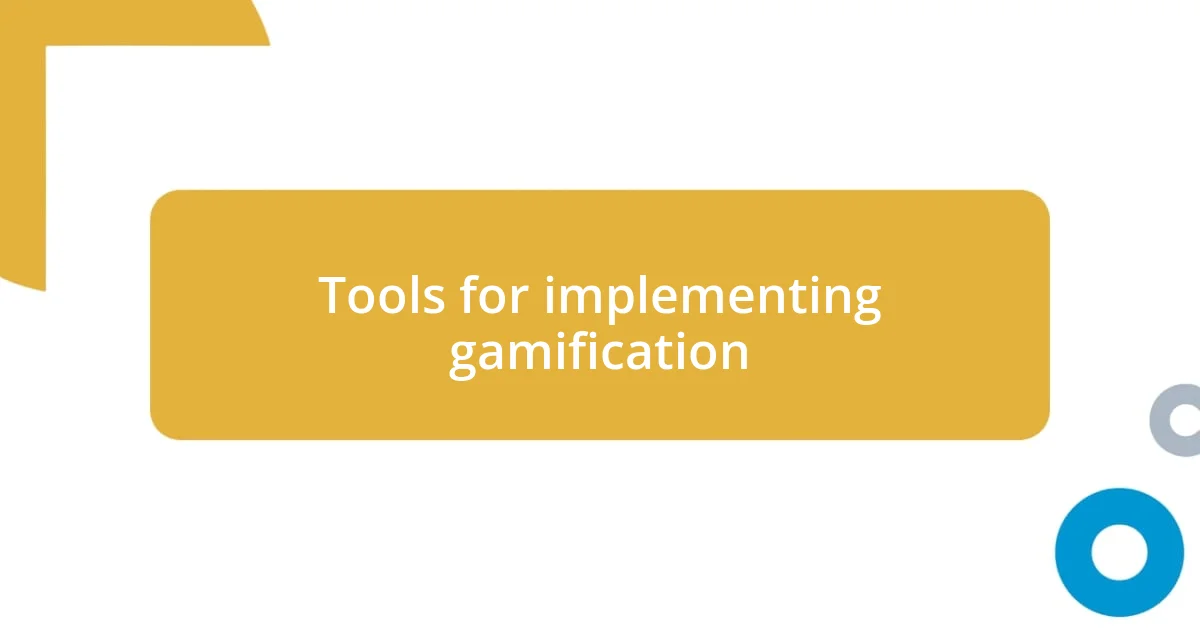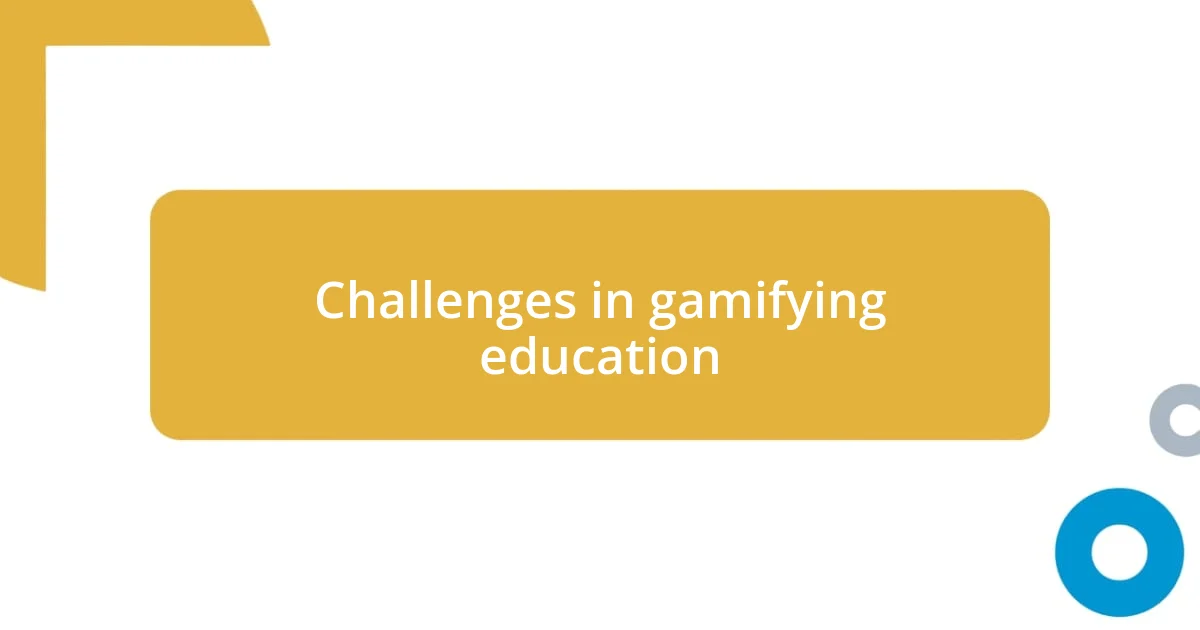Key takeaways:
- Gamification enhances student engagement and motivation by using game elements like points and badges, fostering a lively learning atmosphere.
- Effective techniques include storytelling, interactive leaderboards, and educational quests, which transform traditional lessons into immersive and collaborative experiences.
- Future trends in gamification may incorporate AR/VR for immersive learning, personalized learning paths, and data analytics for real-time progress tracking.

Understanding gamification in education
Gamification in education is essentially the use of game elements to enhance the learning experience. I remember when I first encountered it in a classroom setting—students were completely absorbed in lessons that resembled games rather than traditional lectures. It made me wonder: how could something so engaging transform a mundane experience?
At its core, gamification taps into our natural instincts and desires, such as competition and achievement. I’ve seen students who usually struggled with their studies suddenly thrive when they were given badges or points for completing tasks. It stirred a sense of motivation in them that traditional grading systems often fail to ignite.
It’s fascinating to consider how gamification can create a sense of community among learners, too. Reflecting on my own educational experiences, I realized that group challenges not only fostered collaboration but also enriched friendships. Have you ever participated in an educational game where the atmosphere felt electric? That’s the magic of gamification—it has the power to transform learning into something lively and interactive.

Benefits of gamification in learning
One of the standout benefits of gamification in learning is how it boosts student engagement. I recall a particular instance when my younger cousin struggled to stay focused during his lessons. His teacher introduced a trivia game where correct answers led to unlocking levels and earning rewards. The change was remarkable! Suddenly, he was eager to participate and share answers. This highlights how incorporating elements of fun can not only maintain attention but also invigorate the learning process.
Here are some key advantages of gamification in learning:
- Increased Motivation: Game elements such as points, badges, and leaderboards can significantly motivate students to engage with the material.
- Enhanced Retention: When learning is fun, students are more likely to remember what they’ve learned. Games stimulate emotional responses that aid memory.
- Immediate Feedback: Gamified environments often provide instant feedback, helping learners understand their progress and areas for improvement.
- Encouragement of Healthy Competition: This fosters a spirit of friendly rivalry that can push students to perform better while building camaraderie.
- Adaptable Learning: Gamification can be tailored to fit diverse student needs, allowing them to progress at their own pace.
Reflecting on these benefits, it’s clear that gamification breathes new life into education. When students are excited to learn, the outcomes can be truly transformative.

Effective gamification techniques for classrooms
In my experience, incorporating storytelling into classroom gamification techniques can create deeper connections to the material. I recall when a teacher turned a history lesson into an adventure that placed students in the shoes of historical figures. It was incredible to see how students who usually disengaged found themselves eagerly participating—discussing strategies and outcomes as if their choices shaped history. This technique taps into emotional engagement, which can make the lessons resonate far beyond the classroom.
Another effective technique I’ve seen is the use of interactive leaderboards. I remember witnessing the transformation of a rather quiet classroom during a spelling bee competition where students earned points and ranked on the board. The energy was palpable as they cheered each other on, and it fostered a sense of belonging. This friendly competition sparked not just individual ambition but also teamwork, pushing students to help one another perform better. It’s a vibrant testament to how gamification nurtures community alongside personal achievement.
Designing educational quests can also be a game-changer. I once developed a semester-long quest that had students completing different learning challenges to progress. That approach was particularly effective; it turned seemingly monotonous assignments into exciting missions they were eager to tackle. This transformation showed me how gamifying the educational process can make even the toughest subjects approachable and enjoyable.
| Technique | Description |
|---|---|
| Storytelling | Immerses students in narratives that relate to learning material, creating emotional connections. |
| Interactive Leaderboards | Utilizes friendly competition to foster motivation and community among students. |
| Educational Quests | Transforms traditional assignments into exciting missions that encourage active participation. |

Tools for implementing gamification
When it comes to tools for implementing gamification, I’ve discovered that platforms like Kahoot! can really elevate the classroom experience. I vividly recall a session where we used it for a review game before an exam. The atmosphere was electric—students were shouting answers and laughing together. It transformed a typically tense study period into a fun, competitive environment. Have you ever seen how quickly kids light up when they think they can win a game? It’s a powerful motivator!
Using software like Classcraft also deserves mention. This program turns the classroom into an RPG (role-playing game), where students earn points for academic achievements and even behavior. I can’t help but recall the way a shy student blossomed in that environment, taking on the role of a courageous knight—leading initiatives and even mentoring peers. Doesn’t it make you wonder how pretending can unlock real-life potential?
There’s also a treasure trove of resources like Quizizz, which I find particularly handy for self-paced learning. Students can tackle quiz questions at their own speed, receiving instant feedback. I had students trying to beat their own scores, which not only added an element of fun but also promoted self-reflection and growth. How often do we get to see students take ownership of their learning in such a dynamic way? With these tools, the possibilities for engagement and excitement in education are endless.

Examples of successful gamification
One unforgettable example of successful gamification is when I saw an entire biology class dive into a ‘survival of the fittest’ simulation game. Students were assigned different species, and they had to strategize on resource management while facing various environmental challenges. It was remarkable how their understanding of natural selection deepened as they debated over which adaptations would give them the best chance of survival. It really brought the concepts to life—who knew biology could be this engaging?
Additionally, I remember a particular instance where a high school used escape room-style puzzles to teach algebra. Students raced against the clock to solve equations that would unlock clues to escape the room. The thrill in their voices as they shouted out solutions was palpable! This approach not only made abstract concepts tangible but also cultivated a sense of unity as they collaborated under pressure. Have you ever noticed how problem-solving in a team can spark such camaraderie?
Lastly, I can’t forget to mention the use of Minecraft: Education Edition in classrooms. I observed a group of students creating intricate historical landmarks within the game as they learned about architecture and design. Their pride was evident as they presented their creations to the class, intertwining creativity with academic knowledge in a way that felt natural and exciting. Isn’t it inspiring to see students express their learning through such innovative mediums? These examples truly showcase the diverse potential of gamification in education.

Challenges in gamifying education
Gamifying education certainly brings excitement, but it’s not without its hurdles. One significant challenge I’ve encountered is the balance between competition and collaboration. I’ve seen students who thrive in competitive environments, but others feel marginalized when the focus is solely on winning. How can we ensure everyone feels included while still maintaining the fun of a game? It’s a tricky tightrope to walk.
Another barrier I’ve faced is the varying technology access among students. In one instance, I organized a gamified lesson that required a digital platform. Unfortunately, some students struggled to engage because they didn’t have reliable internet access at home. This made me wonder—how can we create an inclusive environment when resources aren’t evenly distributed? It’s really a call to all educators to consider diverse needs in their gamification strategies.
Lastly, I’ve noticed that not every subject easily lends itself to gamification. I remember trying to introduce game elements in a more traditional subject like literature, but it felt forced and didn’t resonate with the students. It made me realize that while gamification can enhance learning, it’s essential to pick the right context and be flexible. Have you ever found that certain topics ignite passion, while others leave students cold? Identifying those sweet spots can make a world of difference.

Future trends in educational gamification
As I think about the future of gamification in education, I can’t help but feel excited about the potential of augmented and virtual reality (AR/VR). Imagine students not just reading about historical events but actually stepping into them through immersive experiences. Last year, I attended a workshop where educators used VR to take students on virtual field trips, and I was blown away by how much more engaged they were. Can you picture learning about ancient Rome by exploring the Colosseum in 3D? The level of interaction really pushes the boundaries of typical education.
I also see an increasing trend toward personalization in gamification. In my experience, students thrive when learning paths are tailored to their individual interests and skill levels. Recently, I was involved in a project where we allowed students to choose their own missions within a lesson. The excitement on their faces when they could chase what intrigued them was something I won’t forget. Isn’t it amazing how giving students a say in their learning can ignite their passion?
Looking further ahead, I believe we’ll see a deeper integration of data analytics in educational games. Teachers will be able to track student progress in real-time, allowing for immediate feedback and personalized support. I’ve seen the power of data firsthand when using gamified assessments. Just last semester, we implemented a leaderboard that not only showcased progress but also highlighted students who needed extra help. It prompted focused discussions and quick interventions that made a real difference—don’t you find it fascinating how data can transform teaching and learning in such meaningful ways?












